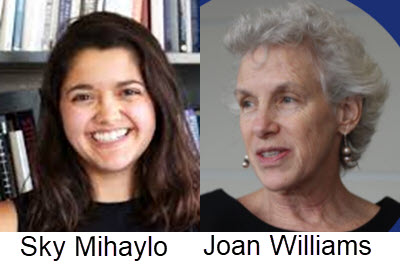Become a Patreon!
Abstract
Excerpted From: Sky Mihaylo and Joan C. Williams, Interrupting Bias: Inside and Outside the Courtroom, 32 Journal of the American Academy of Matrimonial Lawyers 365 (2020) (65 Footnotes) (Full Document)
 In U.S. law firms surveyed last year, only one in five (19.6%) equity partners were women, and only about 6% were racial/ethnic minorities (including men and women). Statistics from 2017 show that openly lesbian, gay, bisexual, and transgender (LGBT) lawyers make up less than 3% of all law firm attorneys, and lawyers with disabilities are counted in at less than 1%. It is clear, the legal profession has a problem with diversity, equity, and inclusion.
In U.S. law firms surveyed last year, only one in five (19.6%) equity partners were women, and only about 6% were racial/ethnic minorities (including men and women). Statistics from 2017 show that openly lesbian, gay, bisexual, and transgender (LGBT) lawyers make up less than 3% of all law firm attorneys, and lawyers with disabilities are counted in at less than 1%. It is clear, the legal profession has a problem with diversity, equity, and inclusion.
In 2018, Joan C. Williams co-authored You Can't Change What You Can't See: Interrupting Gender and Racial Bias in the Legal Profession in partnership with the American Bar Association's Commission on Women in the Profession and the Minority Corporate Counsel Association. The study found that women and people of color are experiencing bias in numerous workplace processes, from hiring and compensation to promotion and mentorship - women and people of color have been persistently held back from advancement. They don't have to be.
Promoting diversity is not just The Right Thing, it makes good business sense. Diverse workgroups perform better and are more innovative than homogenous ones. Gender diverse workgroups have stronger collective intelligence and racially diverse ones are more likely to consider a broader range of alternatives, resulting in better decision making and thoughtful problem solving.
This article will first provide readers with an overview of how to identify bias in the workplace, whom it affects, and how it presents in the legal field. It will also give a brief summary of how workplace sexual harassment affects lawyers. Following these summaries will be an introductory guide to research-backed interventions for workplace bias called “bias interrupters.” With this context, the final section will offer a look at the role of family courts and attorneys in recognizing the value of domestic work in two-partner, sole-breadwinner relationships. This article ultimately offers concrete ways family law attorneys can navigate everyday biases from the office conference room to the courtroom.
[. . .]
Gender and racial bias is not going away overnight, but the practice of ignoring and perpetuating it can. The team at the Center for WorkLife Law collaborated with Monica Biernat, professor of psychology at the University of Kansas, to conduct an experiment examining the impact of the performance evaluations toolkit. All participants completed reviews for hypothetical employees (white and black men and women), but half of the participants were randomly assigned to receive the toolkit and listen to a brief audio recording of the main messages. Preliminary findings suggest that using the toolkit leads to reviewers giving higher ratings, monetary bonuses, and promotion recommendations for both women and black workers. All this from a brief toolkit freely available, along with other resources, at BiasInterrupters.org.
There's plenty left to do when it comes to tackling biases among individuals and within workplaces, but everything outlined above can be used as a roadmap for action today.
Sky Mihaylo is Senior Policy and Research Analyst, Center for WorkLife Law, University of California, Hastings College of the Law.
Joan C. Williams is Distinguished Professor of Law; Hastings Foundation Chair; Director, Center for WorkLife Law, University of California, Hastings College of the Law.
Become a Patreon!


